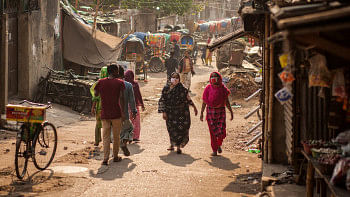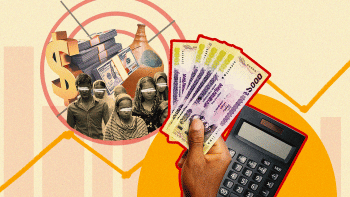What does poverty research in Bangladesh require?

Research on poverty in Bangladesh requires answers to four fundamental questions: i) what are the poverty trends in the country?; do the official figures present a true picture?; ii) how do different shocks (economic and non-economic) affect poverty and vulnerability?; iii) what are the structural factors behind poverty?; and iv) what are the important aspects of addressing poverty in a sustainable way?
According to the Bangladesh Bureau of Statistics (BBS), the headcount poverty rate (as per the cost of basic needs method) in the country declined from 80 percent in the early 1970s to 18.7 percent in 2022. Between 2016 and 2022, the national poverty rate declined from 24.2 percent to 18.7 percent. Both the rural and urban areas experienced a drop in poverty rates. While the official statistics paint an optimistic picture of poverty reduction, alternative surveys suggest a more nuanced reality. According to two rounds of surveys conducted by SANEM in 2018 and 2023, which tracked the same 10,000 households nationwide, the decline in national poverty rate has been slower than reported, while urban poverty has risen. The Multidimensional Poverty Index (MPI), which measures various deprivations at the household level in health, education and living standards, corroborates this trend. The surveys also highlight a worrying trend of increasing inequality, while food security, a critical component of poverty, has worsened too.
The persistent vulnerability among a large section of the country's population remains a pressing concern despite high economic growth, rise in per capita income, export and remittance performances, and microfinance initiatives. Vulnerable households are those who are categorised as non-poor but may fall into poverty due to any economic or natural shocks. SANEM's surveys indicate that the pandemic caused a sudden spike in poverty rates, reversing some of the progress made before. Climate change poses another significant threat to development. My recent research suggests that if there is inaction in addressing climate change, a rise in temperature by two degrees Celsius by 2040 could increase the headcount poverty rate in Bangladesh by 3.5 percentage points. The ongoing inflationary pressure adds woe to the vulnerabilities. The coping strategies to different shocks, available to poor and vulnerable households, remain limited and repeated shocks make these households exhaust those limited options.
In-depth poverty research in Bangladesh requires understanding the structural factors behind poverty. The ownership structure plays a critical role, as unequal distribution of assets can lead to wealth concentration in the hands of a few. The labour market is another determinant; limited access to well-paying jobs and the prevalence of low-wage work perpetuate a cycle of poverty. Gender disparities further compound poverty, particularly for women who often face barriers to equal rights in property, receiving equal pay, and are sometimes subjected to practices like child marriage, which can limit educational and economic opportunities. Exclusion based on ethnicity, disability or social stigma can restrict access to resources and services, leading to entrenched poverty.
A significant aspect of Bangladesh's labour market is its informality, which leads to a lack of job security, benefits, and legal protections for workers. Unemployment and underemployment are persistent issues. Among the youth, the NEET (not in education, employment, or training) rates are concerning, pointing to a generation at risk of being left behind. The labour force participation (LFP) among females remains low due to cultural norms and structural barriers. Workers face poor working environments, low wages, and little to no social security. Occupational rigidities, such as difficulty in transitioning between jobs or sectors, further exacerbate the situation. Lack of opportunities for productive and diversified employment means that workers are often stuck in low-value, labour-intensive jobs with little chance for advancement or skill development. This situation can be called the "low pay, low productivity, and low compliance" cycle.
Bangladesh's economic, social and institutional paradigms shape the pathways to poverty reduction. The economic paradigm is related to the pattern of structural transformation of the economy. Despite notable progress over the past five decades, the lack of economic and export diversification undermines the prospects of reduction in poverty and vulnerability in a sustainable manner. The policy regime, related to the pattern of structural transformation, has remained narrowly focused towards supporting a few sectors. There is a need for productive economic and export diversification supported by a broad-based policy regime.
The social paradigm refers to the pattern of social development. Over the past five decades, there have been some notable improvements in health and education. Success in health and education came with finding some low-cost solutions to addressing child and maternal mortality, and a rise in school enrolment. However, with the evolving demographic structure of the population and growing demand for high-skilled labour, the current and future outlooks remain bleak. Low public spending on health and education and inefficiencies in these sectors act as barriers to reaping the benefit of demographic dividends.
The institutional paradigm refers to the quality of institutions and the political economy of development. In Bangladesh, weak formal institutions, in the form of weak state capacity, weak regulatory regime, prevalence of corruption, crony capitalism and dominance of informal institutions, seriously undermine the scope for enhancing the capabilities of poor and vulnerable people. For example, the weak state capacity in mobilising tax revenue limits the state's capacity to spend high on health, education, and social protection. At the same time, high reliance on indirect taxes leads to a regressive tax system that affects poor people.
We can highlight three important aspects for sustainably addressing poverty in Bangladesh. First, there should be a meaningful solution to the ownership issue. The economic, social, and institutional paradigms for poverty alleviation have to ensure that both material ownership and the feeling of ownership among poor and vulnerable people are enhanced. Second, economic and social capabilities of poor and vulnerable households have to be enhanced through economic diversification, labour market reform, and investment in health and education. And third, the state has to effectively redistribute resources from rich to poor through taxes and social expenditures.
Dr Selim Raihan is professor of economics at the University of Dhaka and executive director of South Asian Network on Economic Modeling (SANEM). He can be reached at [email protected].
Views expressed in this article are the author's own.
Follow The Daily Star Opinion on Facebook for the latest opinions, commentaries and analyses by experts and professionals. To contribute your article or letter to The Daily Star Opinion, see our guidelines for submission.

 For all latest news, follow The Daily Star's Google News channel.
For all latest news, follow The Daily Star's Google News channel. 











Comments